K.A.A. Gent is a club that has been investing in young players recently. The Belgian team secured the signatures of sought-after young players in the January transfer window, including 19-year-old winger Momodou Lamin Sonko from BK Häcken and 21-year-old central defender Hugo Gambor from USL Dunkerque.
The club do not just venture into the transfer market to bring in young talents. Gent has a thriving youth academy that many famous faces have benefited from. Manchester City star Kevin De Bruyne spent six years at Gent during his youth career before moving on to Genk and then Chelsea. Jonathan David joined the Belgian side as an 18-year-old and made over 60 appearances for De Buffalo’s before signing for Ligue 1 side Lille in the summer of 2020.
Moreover, continuing their focus on providing young players with first-team opportunities, 19-year-old left winger Matias Fernandez-Pardo has recently been promoted to the senior squad from the youth system.
Thanks to the youth scouting platform EYEBALL, we can thoroughly scout players at youth levels. In this tactical analysis, we will focus on three central defenders in the Gent youth system who have been putting in some impressive performances. We will analyse how they fit into the team’s tactics and asses whether we think they could be part of the Belgian side in the future.
Senior team tactics
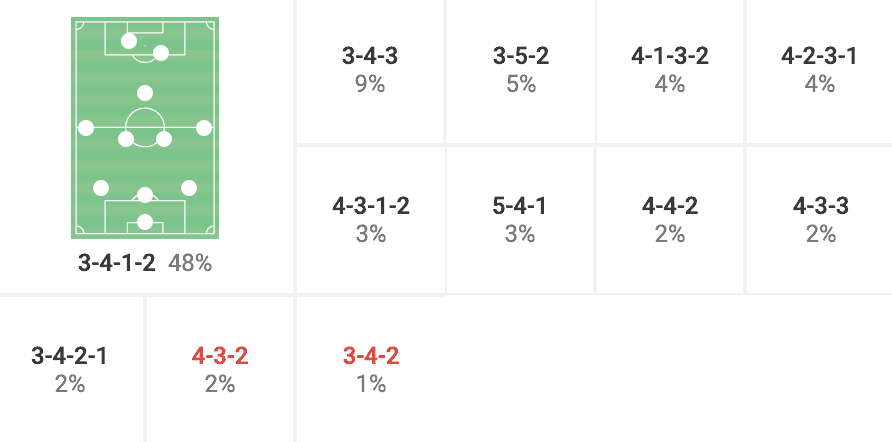
The graphic shows that throughout the 2023/24 season, manager Hein Vanhaezebrouck has ensured the Gent senior team primarily utilises three at-the-back systems. Ismäel Kandouss, Tsuyoshi Watanabe and Jordan Torunarigha are typically the three central defenders the manager opts for. In this analysis, we will look at the Gent youth system to identify three potential replacements from within so that when the time is right, the Belgian side can turn to their youngsters, and we can see them step up into the first team.
Jorthy Mokio
The first youth player we are going to look at in this scout report is 15-year-old Jorthy Mokio. The left-footed youngster is a highly versatile player who can play in several different roles. Primarily a centre-back, usually on the left side of a back three, Mokio can also play as a central defender or left-back in a back four.
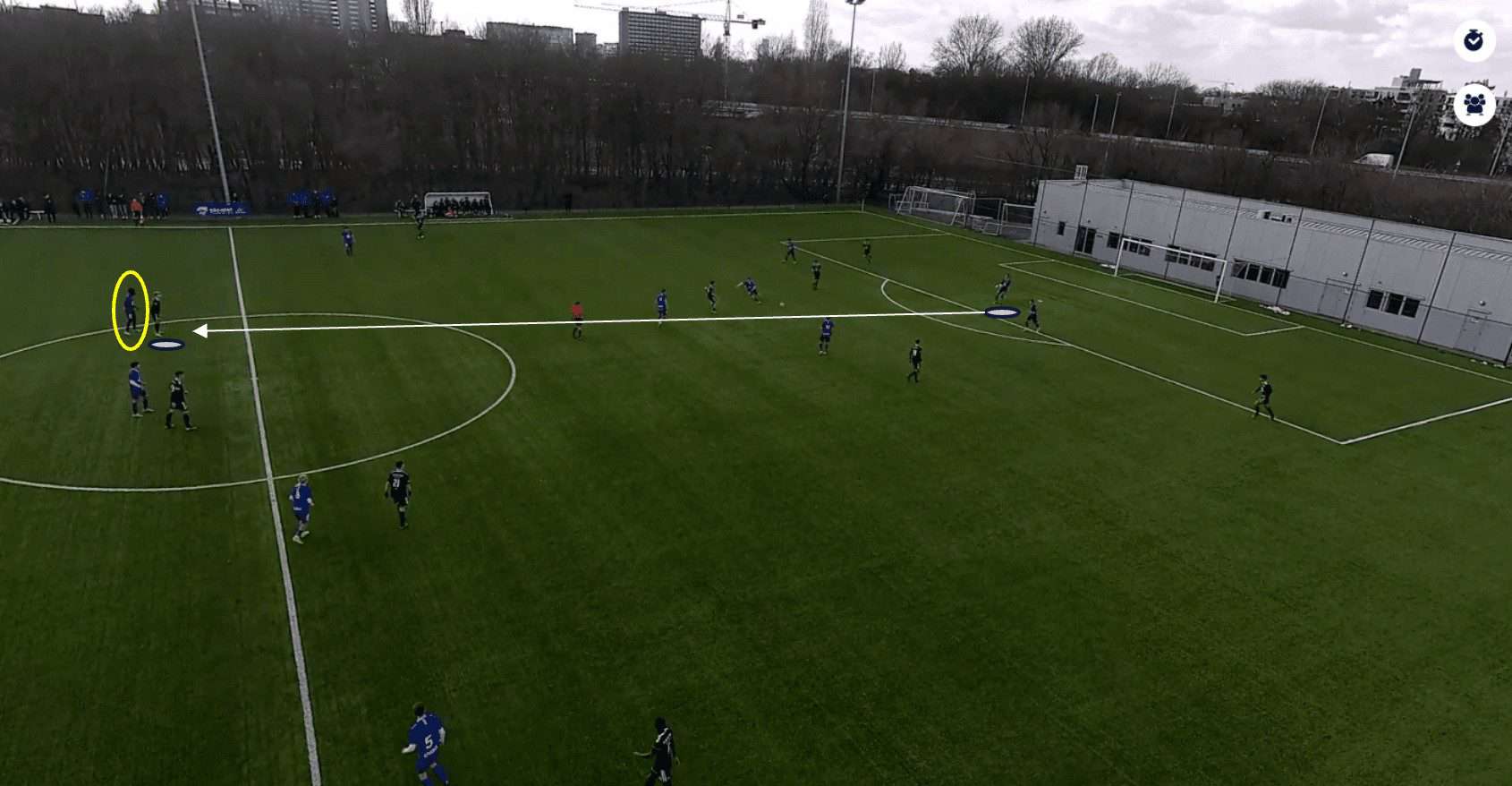
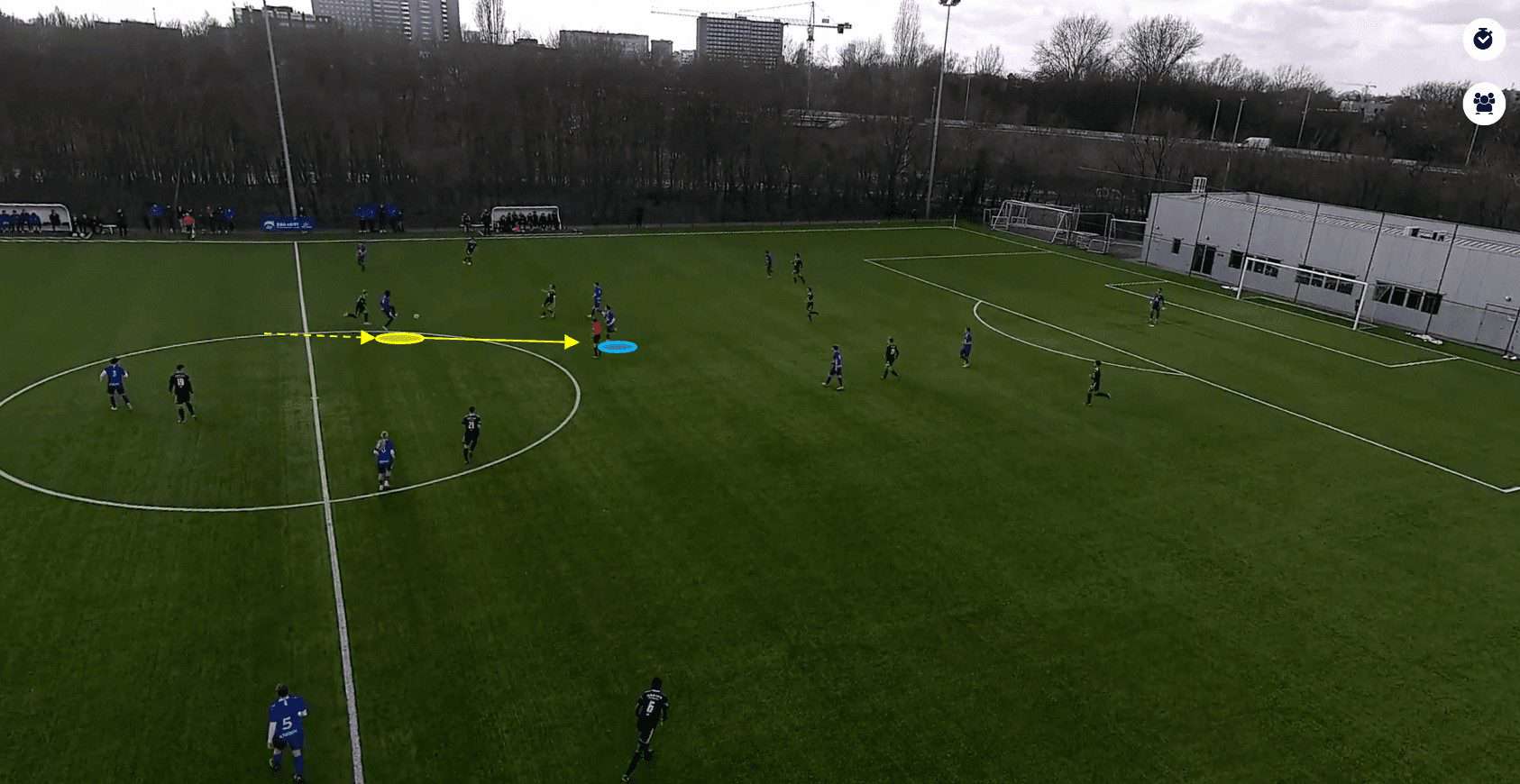
Mokio is a highly proactive defender who plays on the front foot. Here, the opposition goalkeeper launches a pass, looking for his attacker. Mokio, though, has other ideas. He reacts quickly and utilises his short burst of acceleration to get in front of his opponent and intercept the pass. The 15-year-old also has the composure to calmly play the ball into the feet of his teammate.
By defending proactively, Mokio contributes to disrupting the opponent’s attacking rhythm. He shows that he is capable of anticipating and intercepting passes or making timely challenges; this prevents the opposition from comfortably building up play and creating goal-scoring opportunities.
This can lead to Gent regaining possession higher up the pitch, reducing the defensive burden on the team. Moreover, this shows he can play within a team that has a high-pressing or aggressive defensive strategy. This means he can force turnovers in dangerous areas, allowing for quick transitions from defence to attack and catching the opposition off guard.
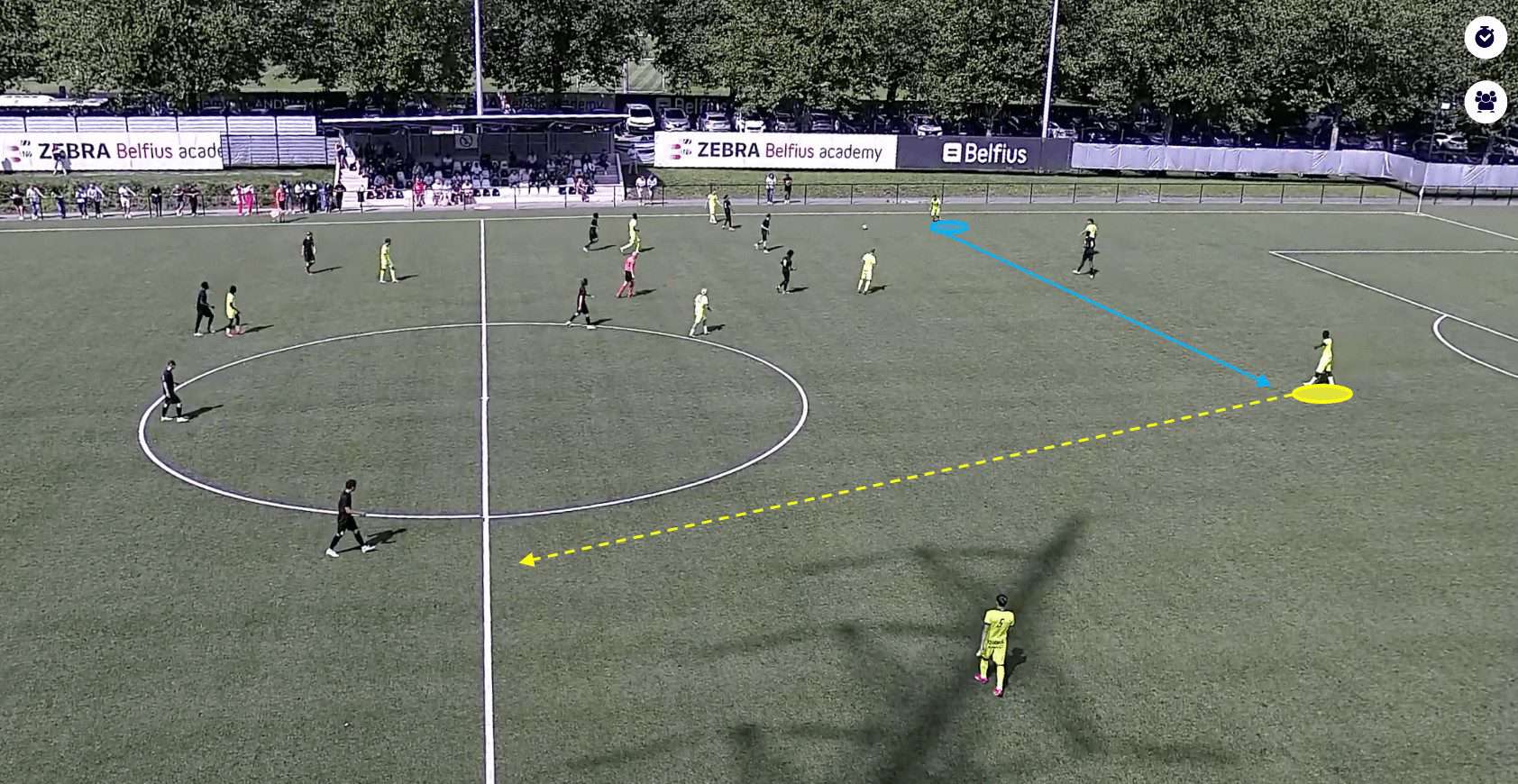
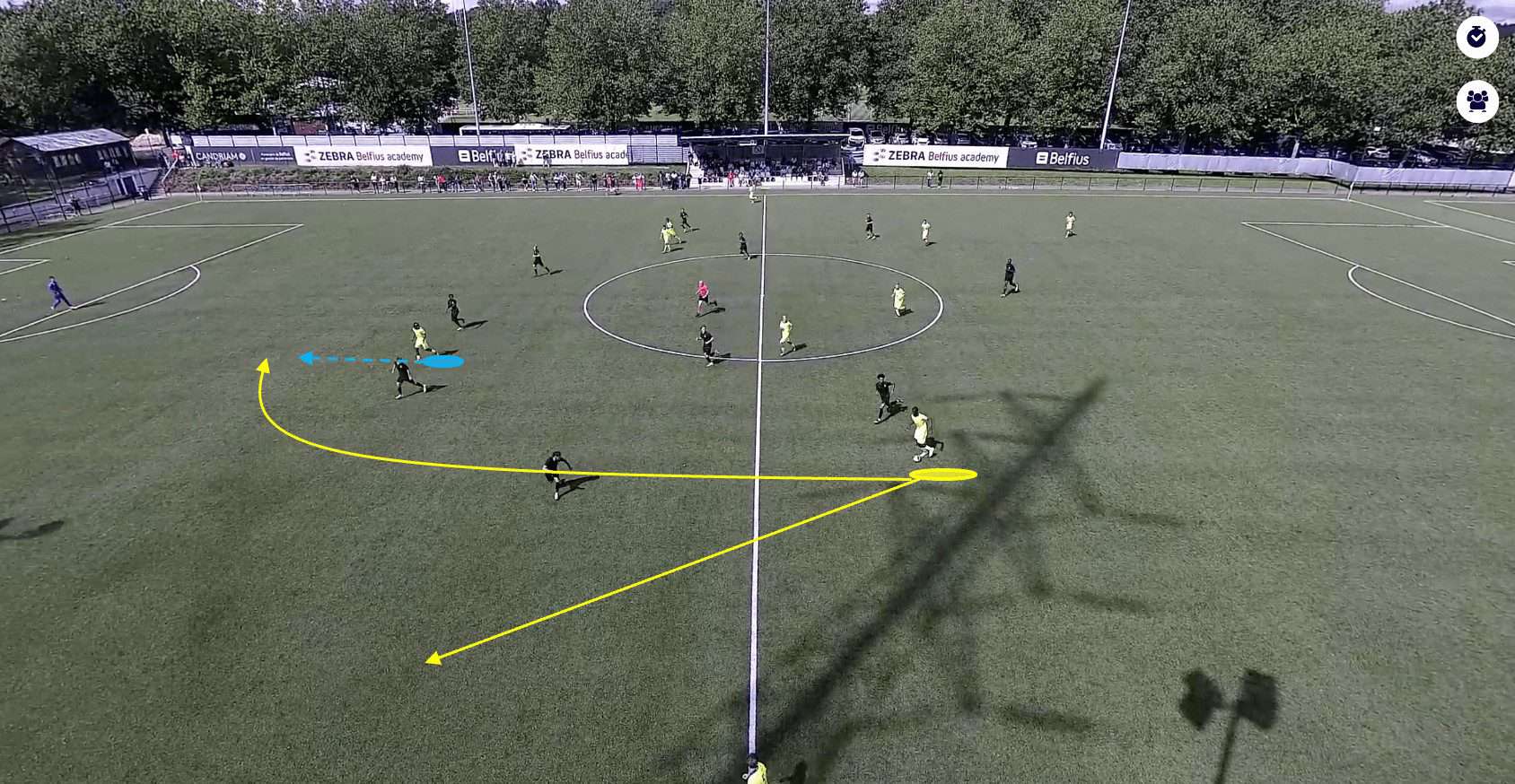
Regardless of the position he is playing, when he sees open space ahead, Mokio’s first instinct is to carry the ball forward. In this scenario, he progresses the play and finds himself in a position where he has a couple of passing options. Typically, the 15-year-old is not overly adventurous with his passing and will usually keep it simple; in this situation, he passes out wide rather than playing the more difficult pass in behind the defensive line.
Consequently, Mokio retains a high pass accuracy rating of 89%. On one hand, this means he is reliable in possession, and most of his passes find their intended target. This does mean that he sometimes misses opportunities to play line-breaking passes that cut through opposition defences and facilitate rapid counterattacks.
However, Mokio’s calmness in possession adds an element of progression to the team’s buildup play. By advancing with the ball at his feet, the defender can bypass opposition players and initiate attacks from the back. This really helps in transitioning smoothly from defence to attack, often setting the tone for Gent U18’s offensive movements.
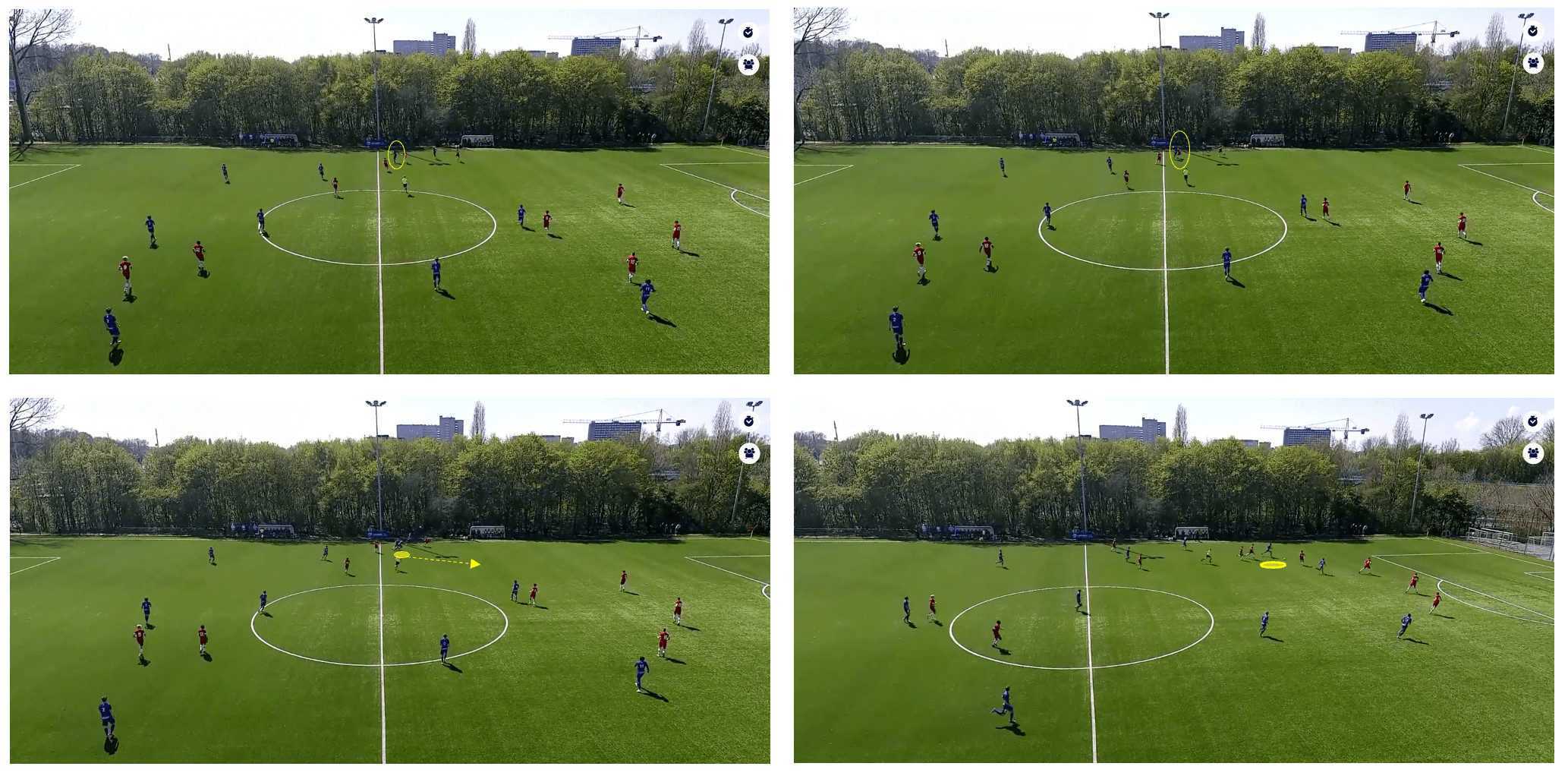
Mokio averages 1.62 take-ons per 90, which he uses to bypass his opponent skilfully and progress Gent up the field. Here, he flicks the ball over his opponent and uses his speed to break away into the opposition half.
When facing a well-organised opponent, Mokio’s ability to dribble past opposition players can disrupt defensive structures and create openings. This not only adds unpredictability to the team’s play but also serves as a valuable tool in unlocking stubborn defensive lines.
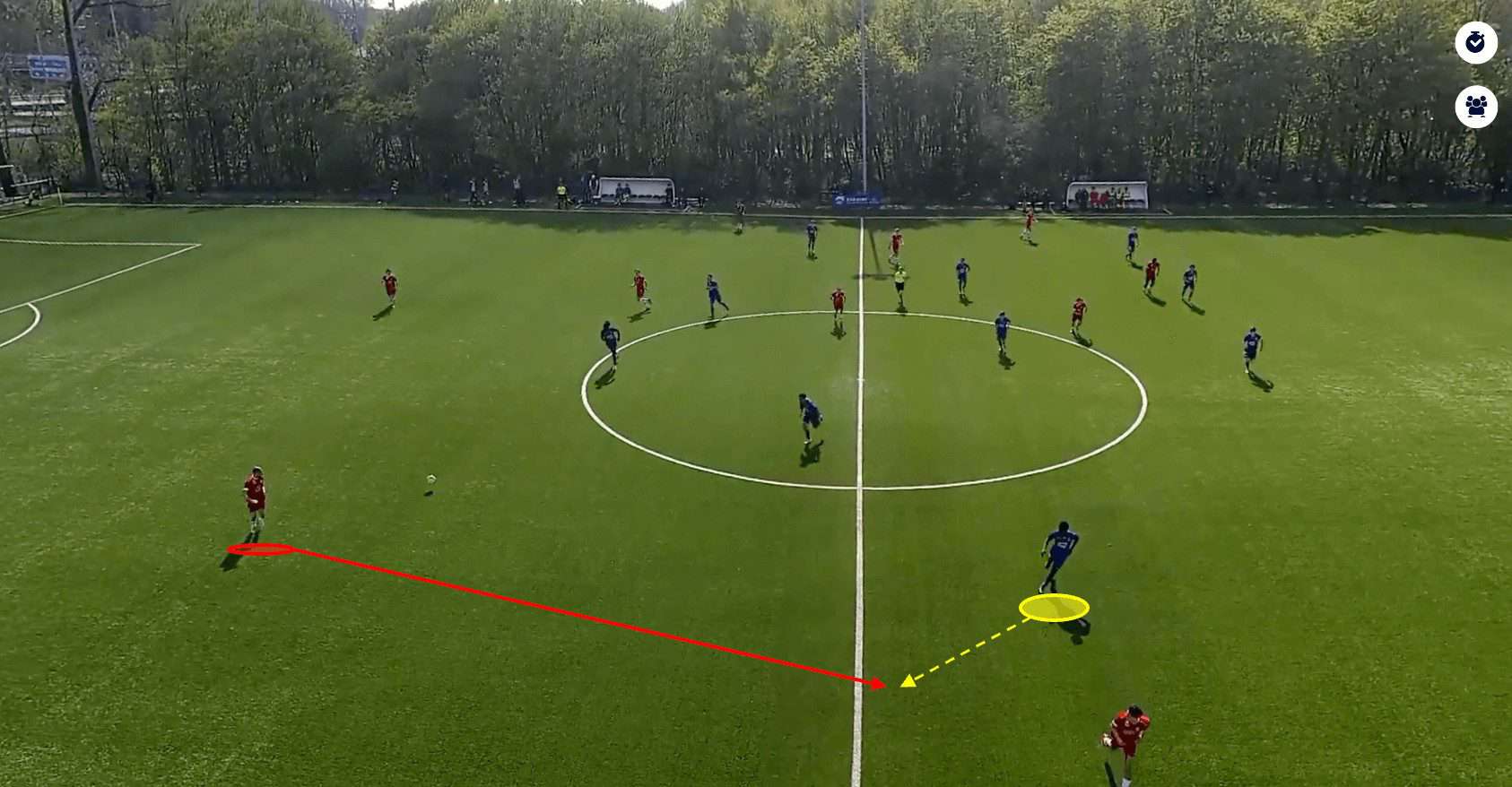
The Gent defender uses his speed to facilitate all aspects of his game; this is a crucial reason why he is sometimes utilised as a left-back, such as in this game against Antwerp U18s. Here, we can see that he reads the game well, staying close to his opponent, and when the ball is played, he steps in to make the interception.
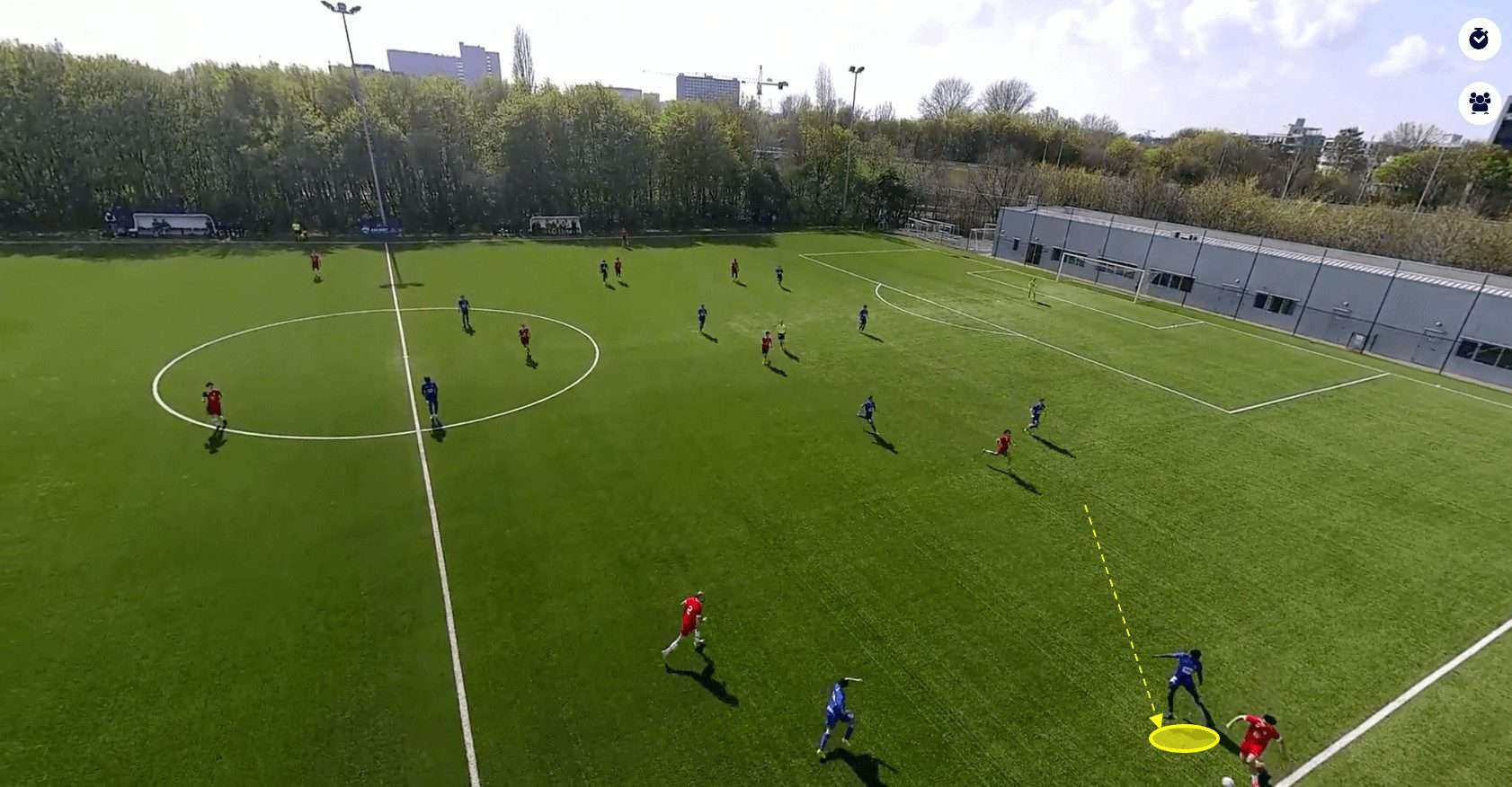
Additionally, he follows his opponent like a shadow, always ensuring he is close enough to close off a passing lane or make an interception. Here, he moves rapidly to close down the opponent and prevent him from turning and carrying the ball down the flank.
Mokio is a highly effective defender, whether in central defence or at left-back. At 15, he already has excellent physical attributes and tactical intelligence, which will help him as he progresses through the youth ranks.
Nicolas Thienpont
The next player we are going to look at in this analysis is 17-year-old Nicolas Thienpont. Much like Mokio, Thienpont is another left-footed central defender; he is happy to play as the central defender in a back three or on either side of central defence in a back four.

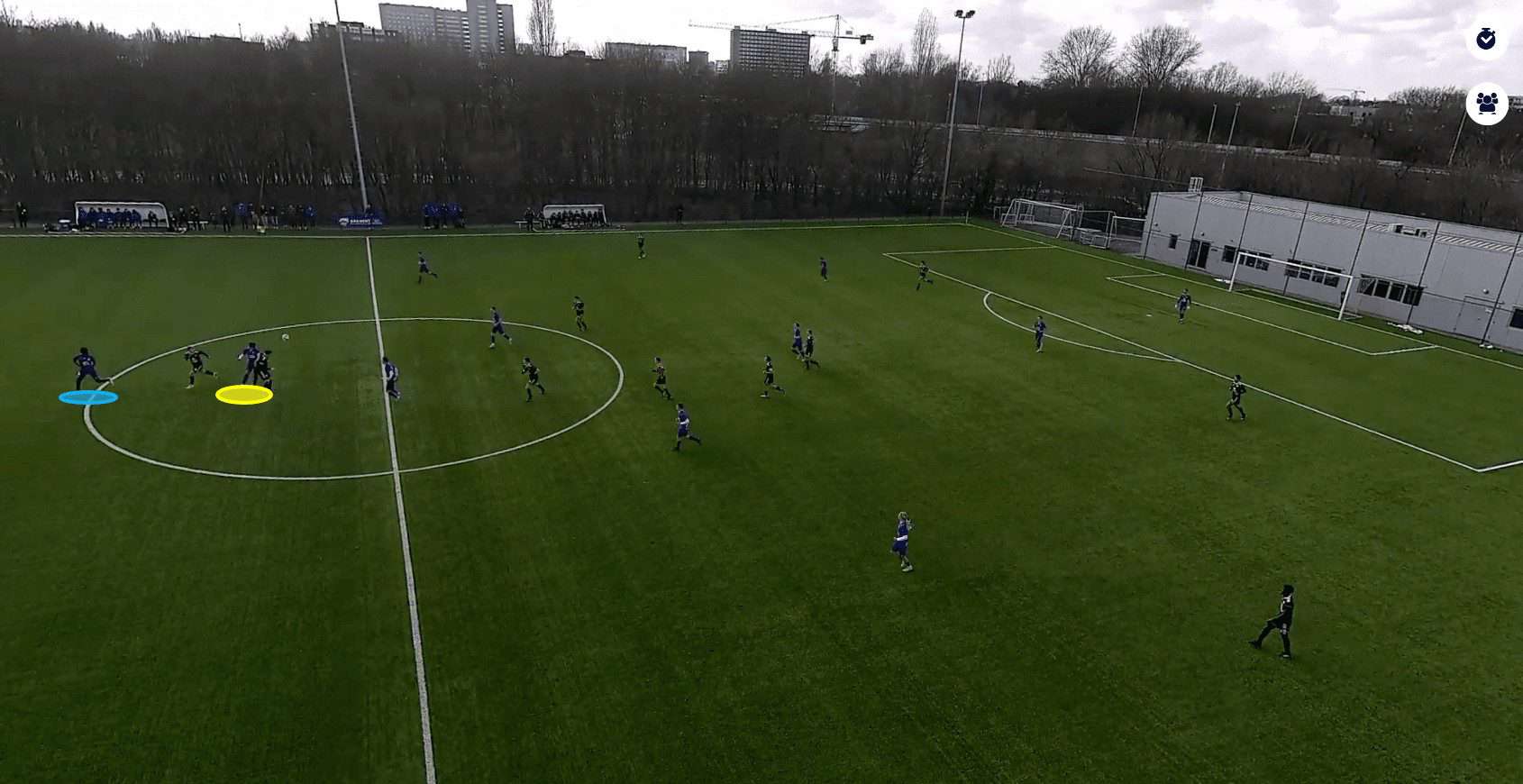
Thienpoint is a classic defender in the sense that he thrives in duels, both aerially and on the ground. The 17-year-old averages 4.0 aerial duels per 90; he uses his positioning and jumping reach to leap above his opponent and direct a header towards a teammate, as we can see in this example. Furthermore, it is also worth noting how Mokio moves to provide cover for his defensive partner in case he is unsuccessful in the aerial battle.
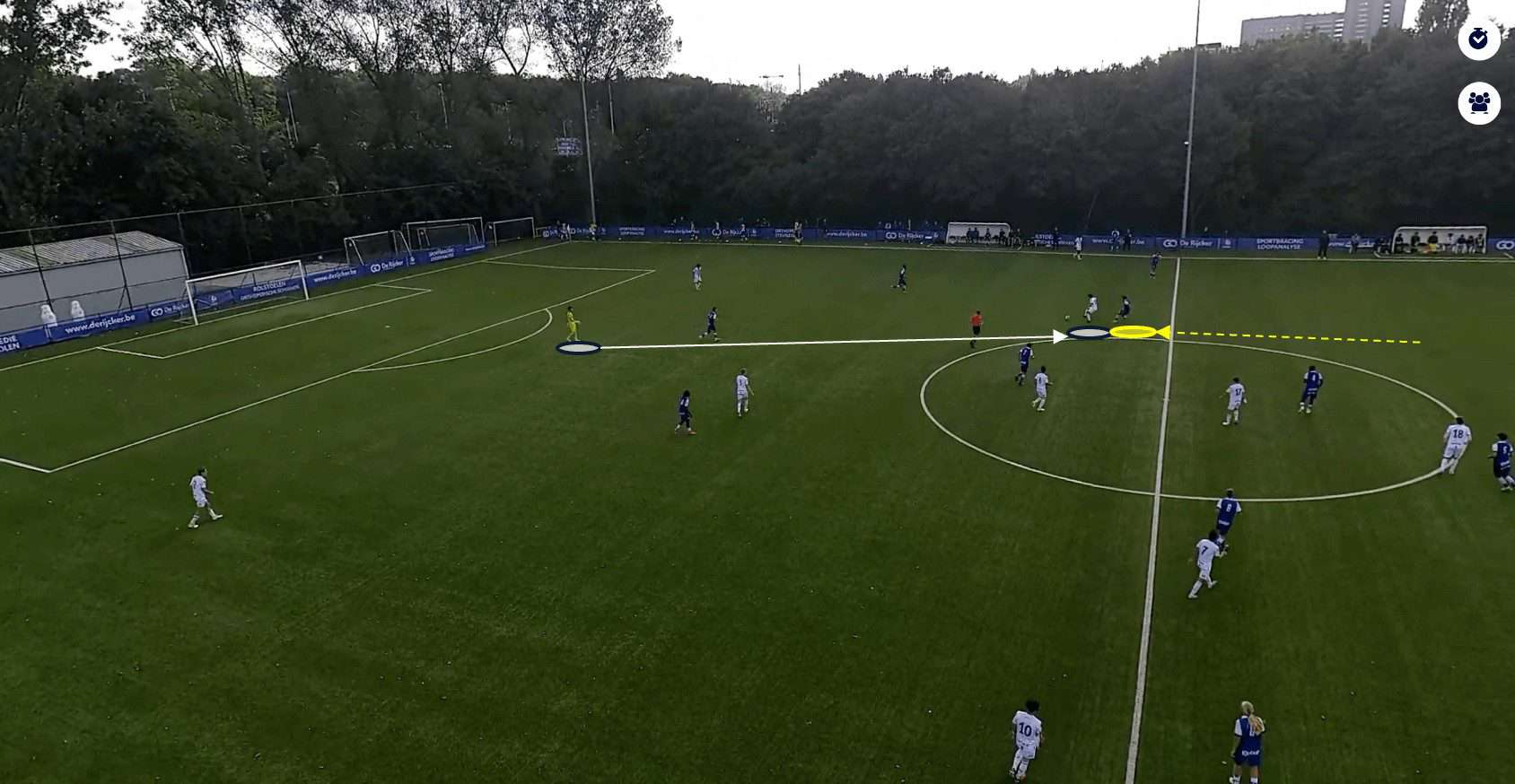
He generally sticks close to his opponent, often stepping up to put him under pressure as he receives the ball, as we can see here. This serves as a proactive measure to neutralise the attacking threat posed by the opponent. By following his opponent closely, the young defender can effectively deny them space to receive passes, turn with the ball, or make dangerous runs and force them to play backwards.
By closely monitoring the movements of the marked opponent, Thienpont increases the likelihood of intercepting passes or dispossessing the attacker. This not only halts the immediate threat but also allows for a quick transition from defence to counter-attack.
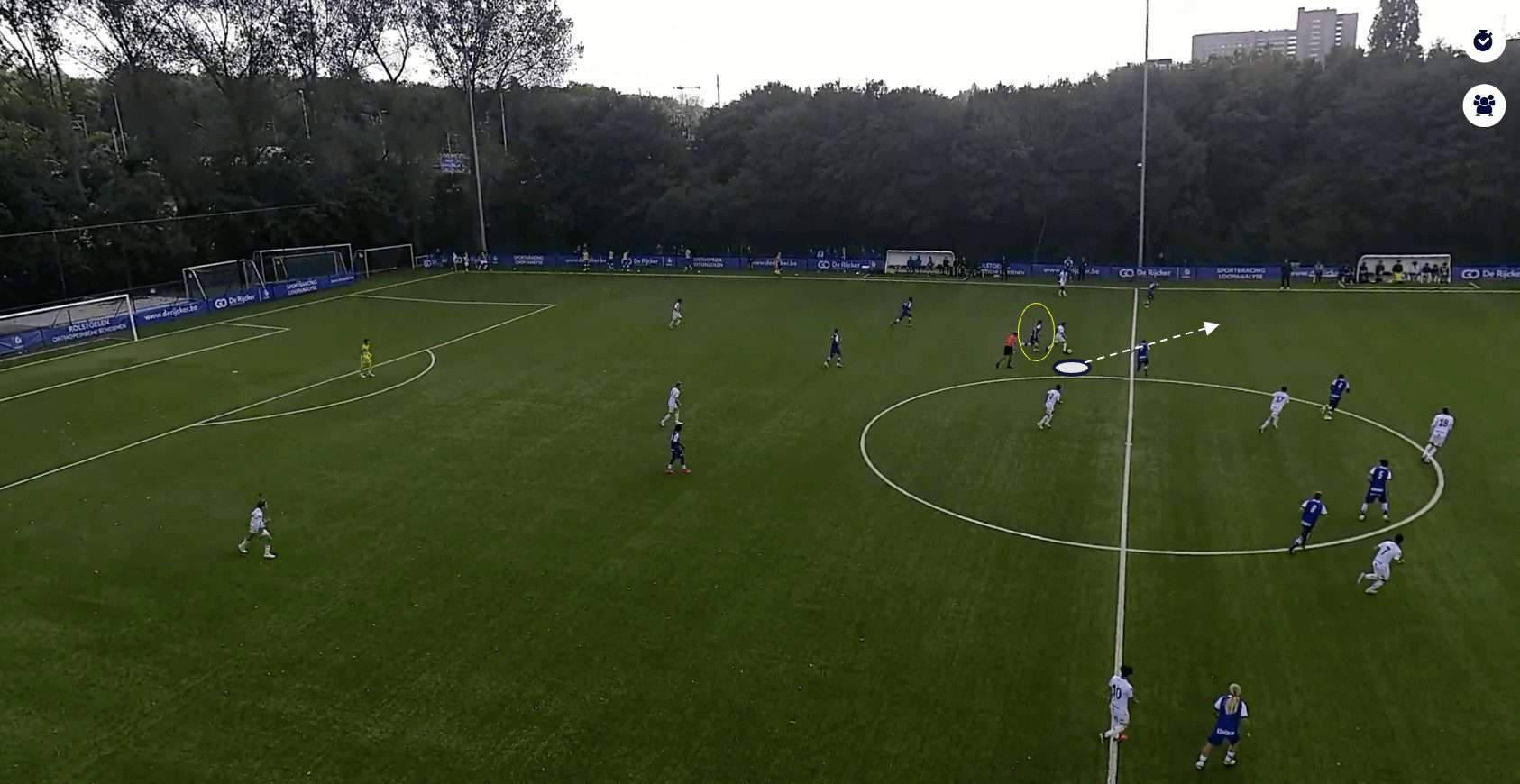
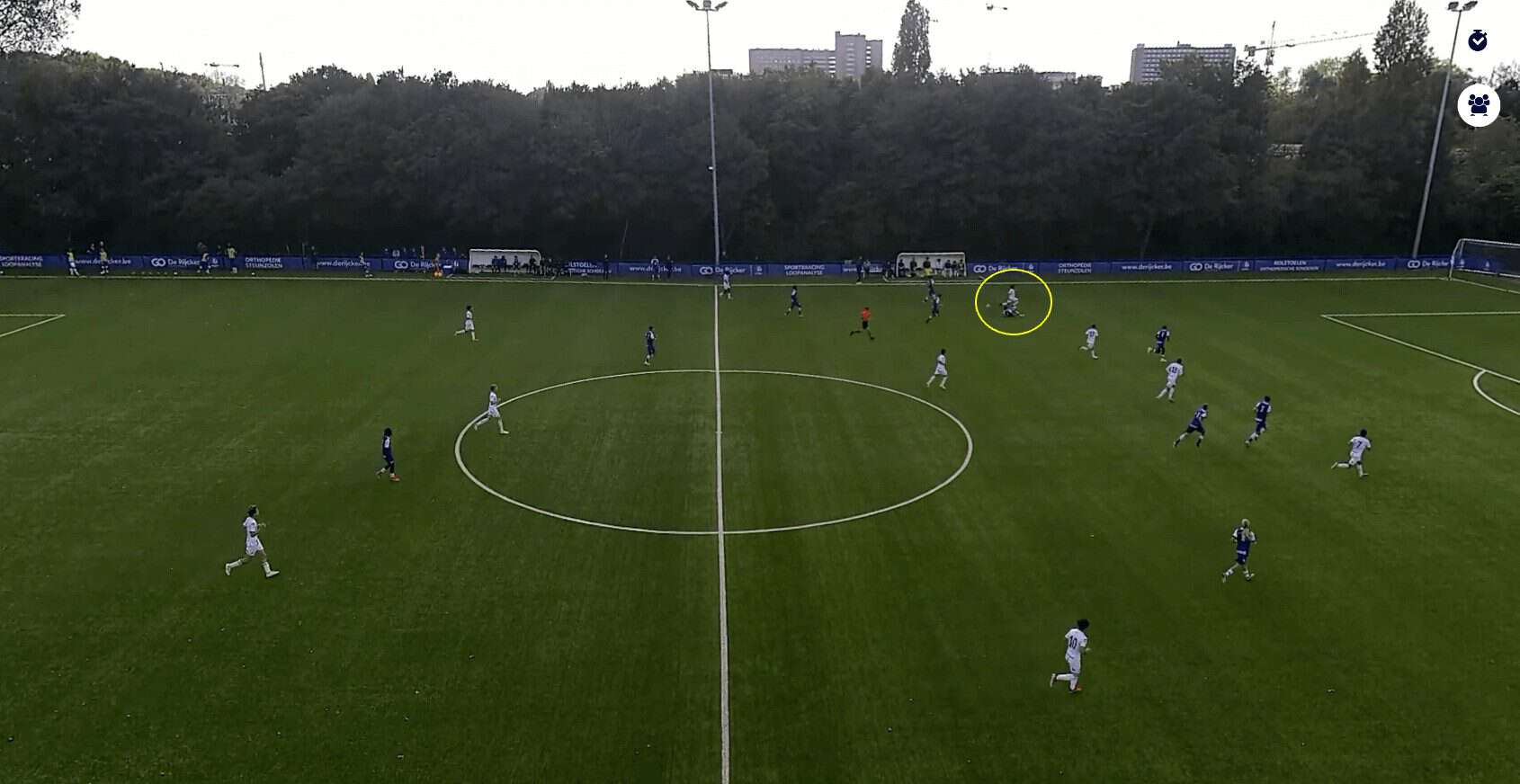
The obvious danger of marking an opponent so closely is that it can lead to Thienpont being spun, as he is in this example. However, Thienpont does possess the acceleration to sprint after his opponent and execute a perfectly times sliding tackle to dispossess the player. This shows just why the central defender averages 4.3 ball recoveries per 90. Whilst getting spun by an opponent is undoubtedly suboptimal, having the work ethic and physical capabilities to recover is a useful aspect of his game.
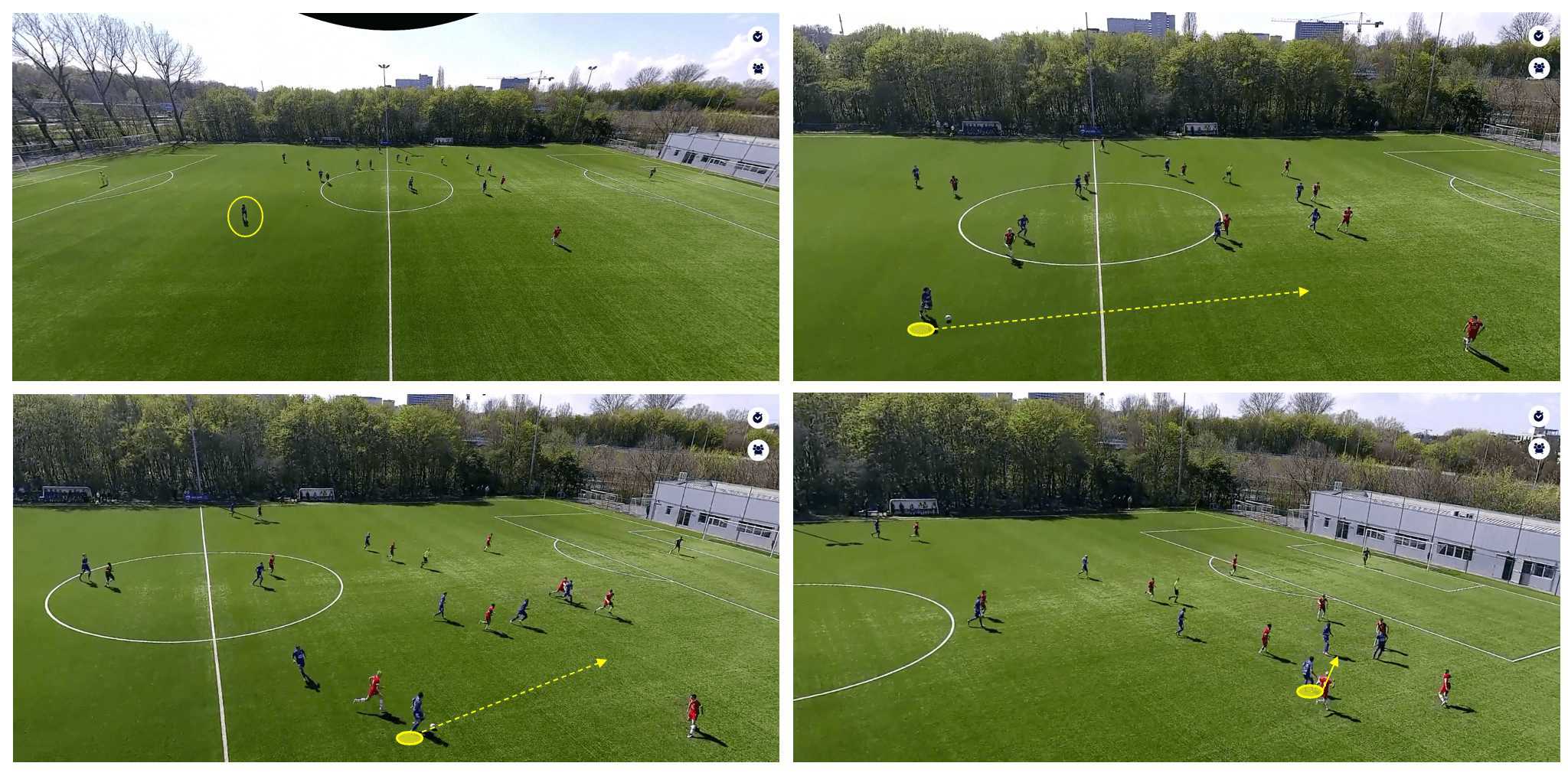
The modern defender is expected to be comfortable on the ball, and just like his teammate, Thienpont is more than happy to carry the ball out of defence. In this instance, he receives a pass from a teammate and charges forward with purpose. The 17-year-old is adept at carrying the ball beyond any opponent, averaging 0.57 take-ons per 90.
This is an effective element of Gent U18’s attacking play; as Thienpont carries the ball forward, opposition players are prompted to close him down, creating gaps in the defensive shape. As his progressive run draws opponents out of position, it shows the defensive vulnerabilities that can be exploited by teammates and creates opportunities for Gent.
Additionally, Thienpont offers an extra passing option during the buildup phase, adding unpredictability to the team’s play. Instead of relying solely on midfielders to progress the ball, the central defender becomes an outlet for a pass, contributing to more diverse attacking options. The defender is usually reliable in possession with an 86% pass accuracy rating, plus he looks to be progressive with his passing, averaging 21 forward passes per 90.
Moreover, this is a way to create numerical overloads in midfield. By engaging and bypassing the first line of the opposition’s press effectively, Thienpont functions as an additional midfielder at various points during the game, allowing the Gent U18 team to outnumber opponents in the central areas of the pitch.
Nicolas Thienpont is a physical defender who loves a battle yet is still calm and composed in possession. He is comfortable being the conduit progressing the play forward and actively involved in Gent U18’s build-up play.
Loris Henry
The final player we are going to look at in this analysis is 21-year-old Loris Henry, who is currently on the fringes of Jong KAA Gent in the Belgian third tier.
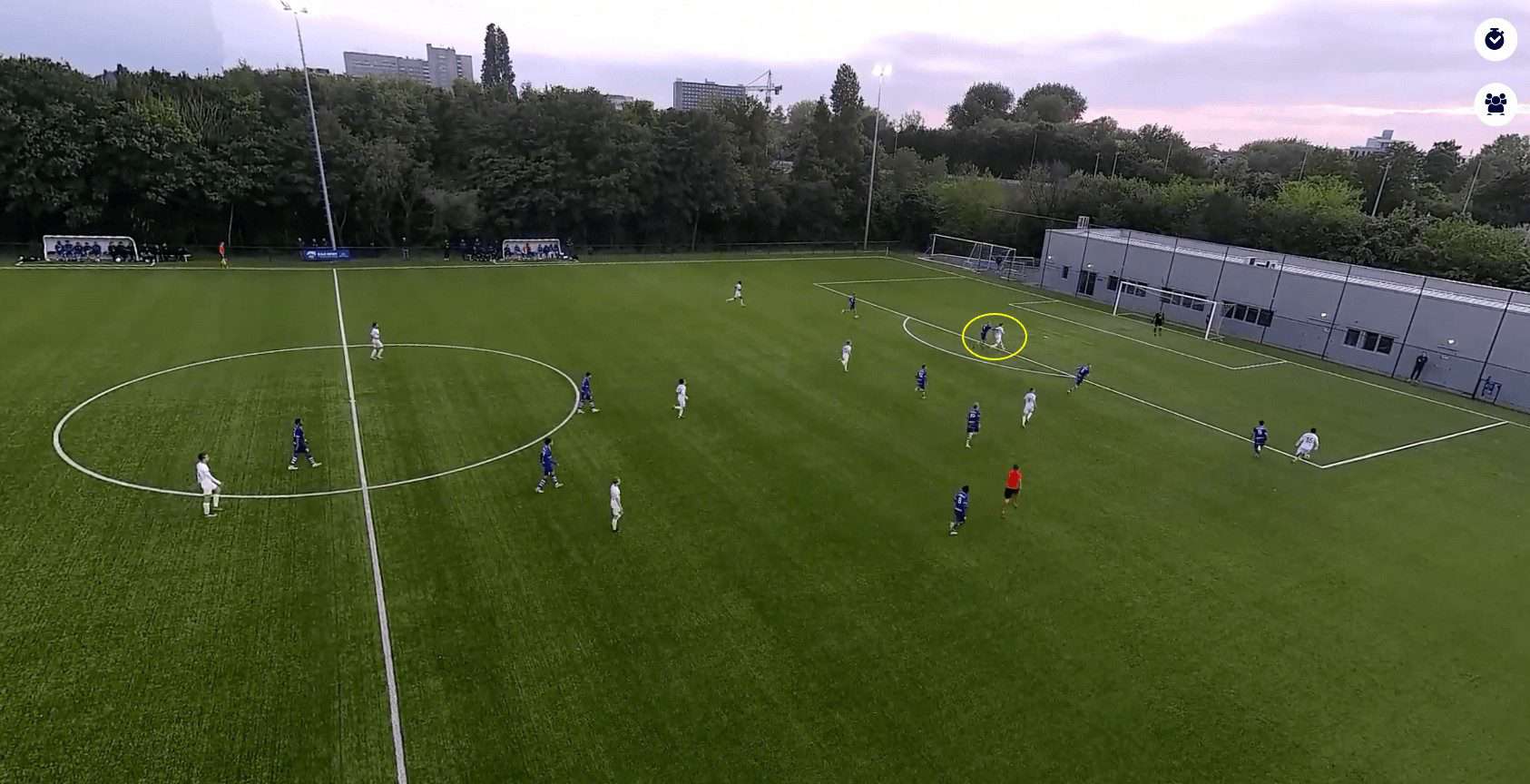
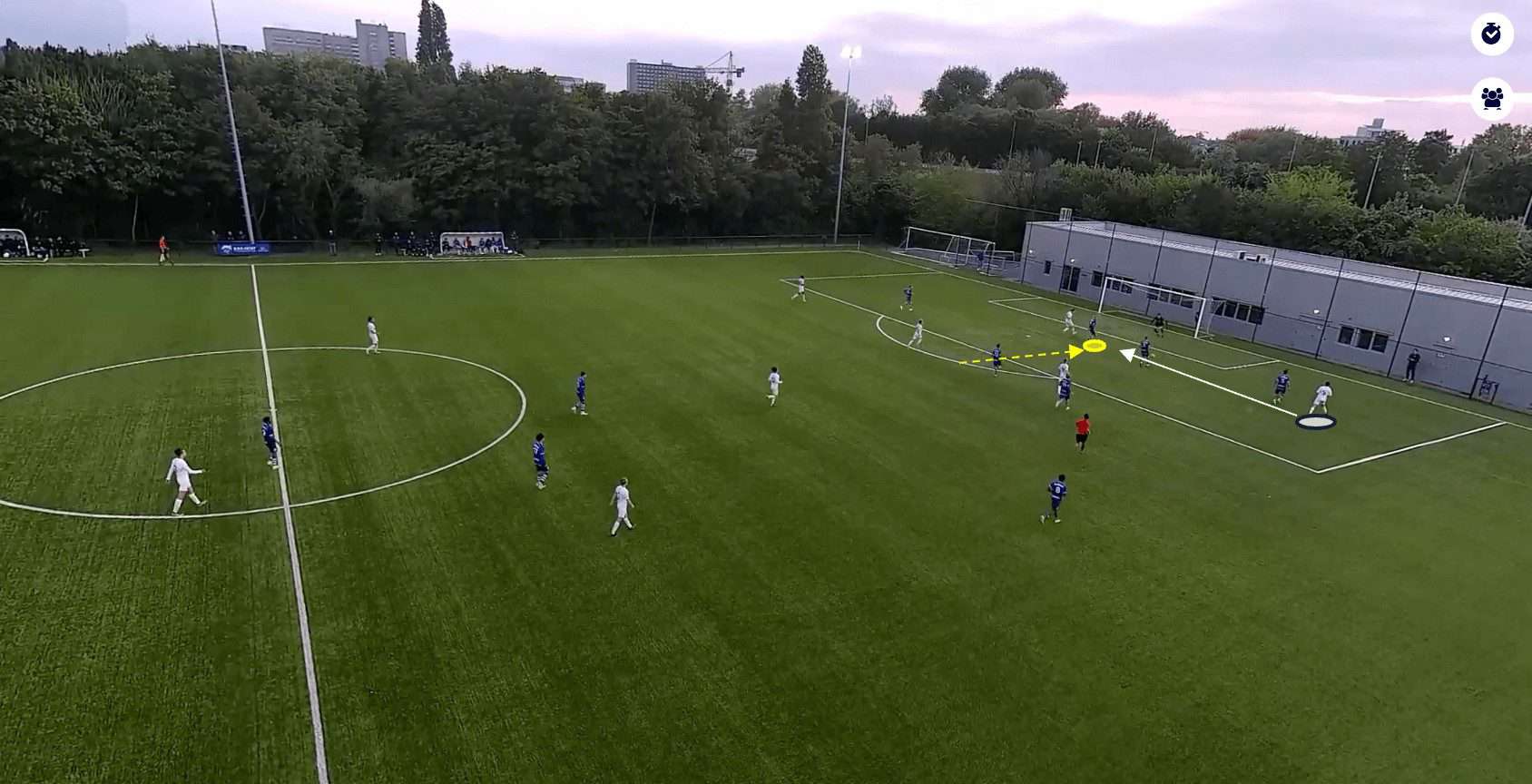
Making last-ditch blocks and clearances is never ideal. Nevertheless, this is something Loris Henry can do very well. He is frequently on hand to provide cover for his teammates and step in when it appears that the opposition is about to find a goal-scoring opportunity.
In this instance, Henry is initially on the wrong side of his opponent, and it seems as though the opposition has a clear chance to play the ball across the penalty area and potentially score a tap-in. Henry has other ideas; he uses his acceleration to quickly alter his run and ensure he is on the right side of his opponent. He then sprints in front and gets into a good position, allowing him to not only intercept the cross but clear it from the penalty area, removing the danger for his team.
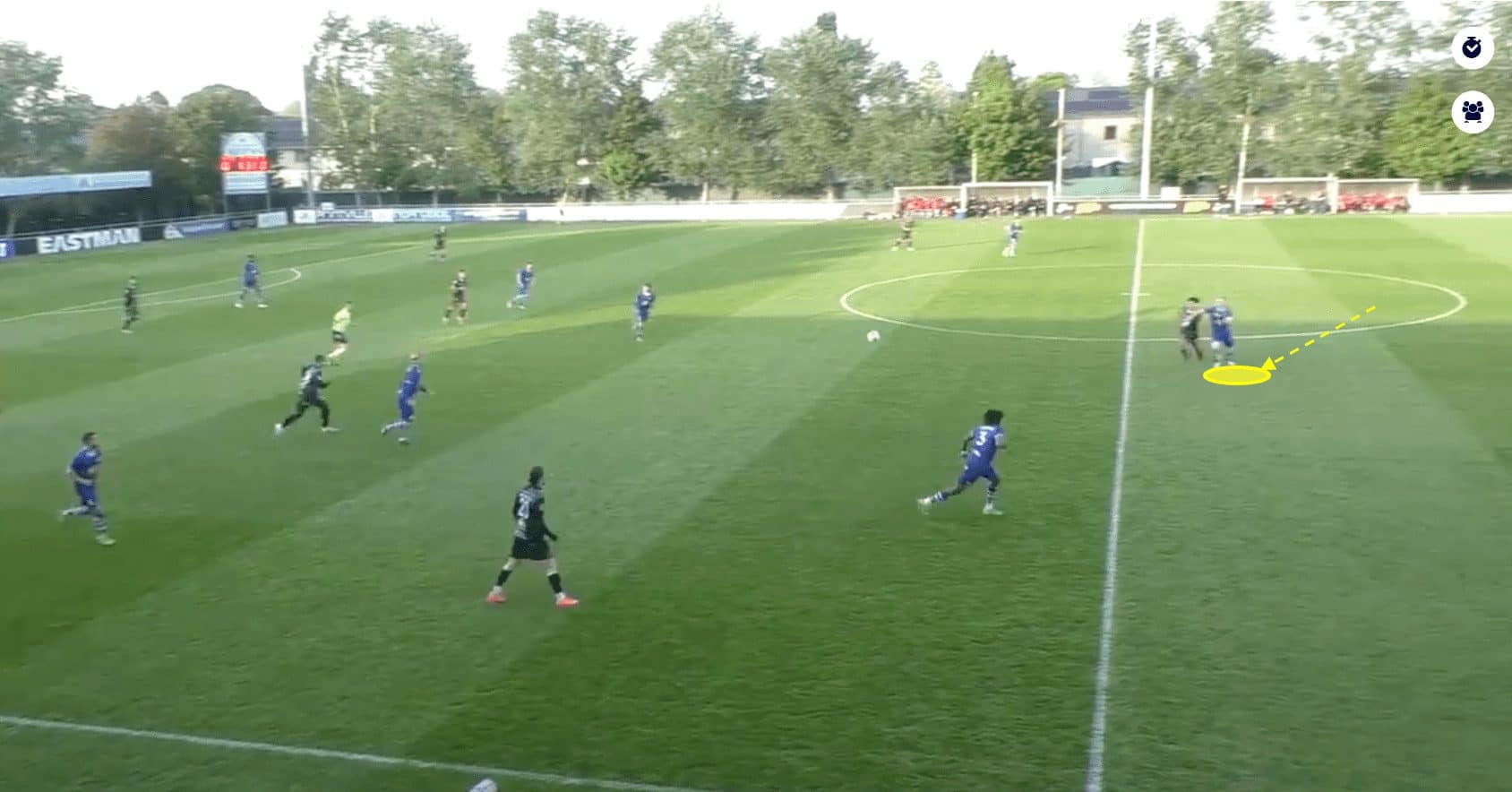
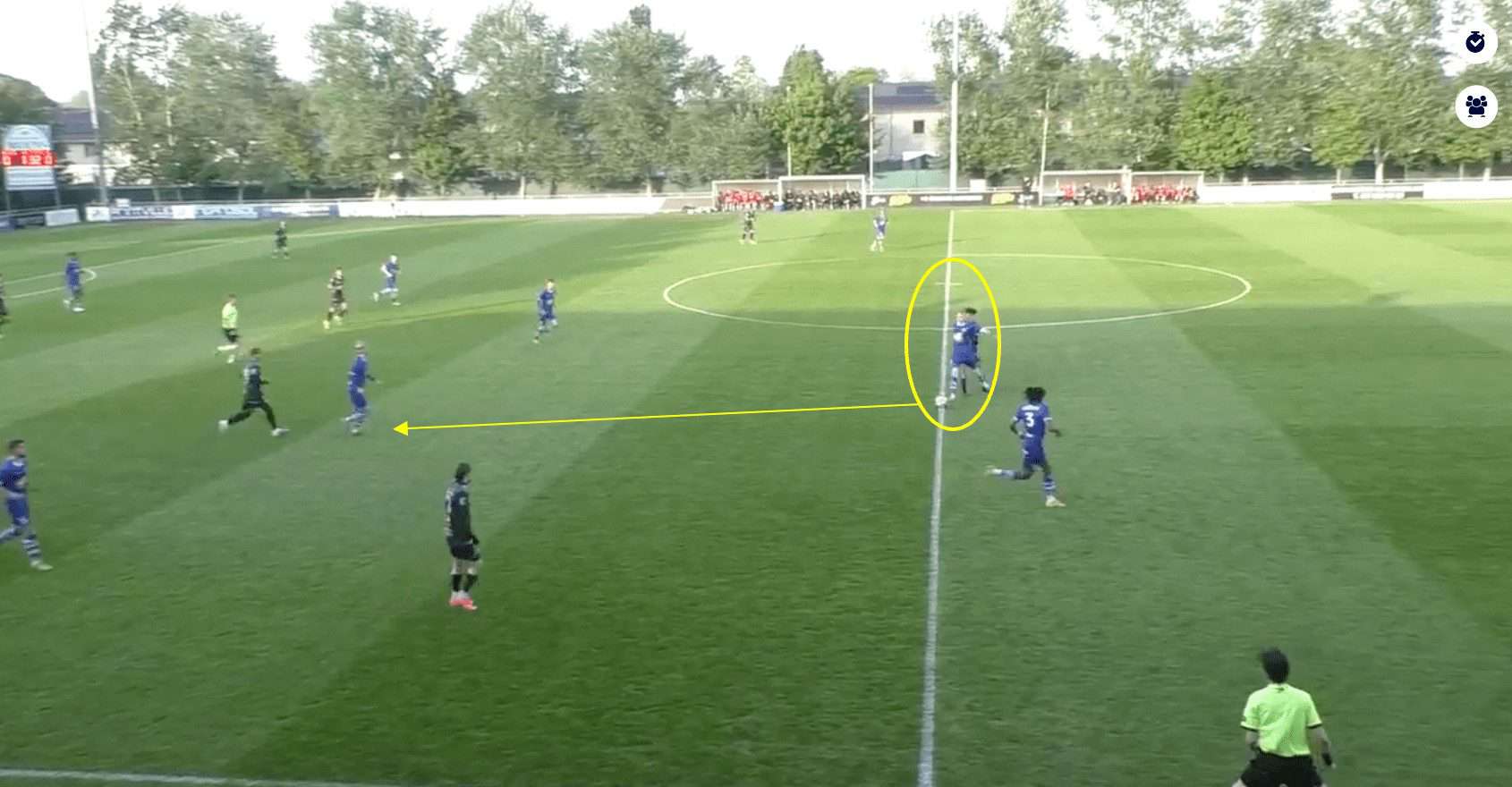
Henry is not one for going to ground unless he has a strong belief he can win the tackle. Instead, he is similar to Mokio in the sense that he prefers to use his speed and strength to reach the ball ahead of his opponent. He sprints ahead and intercepts the pass, which immediately halts the opposition’s attack. The young defender averages 4.4 ball recoveries per 90, and we can see why.
One primary advantage of Henry’s preference to stay on his feet is, of course, the reduced risk of committing fouls. He is less likely to mistime tackles or make rash challenges, decreasing the likelihood of conceding unnecessary set pieces.
By relying on positioning, anticipation, and effective body positioning, he can defend more intelligently without resorting to desperate lunges or sliding tackles. This ensures that the defensive structure remains organised and reduces the chances of leaving gaps in the backline that the opposition can exploit.
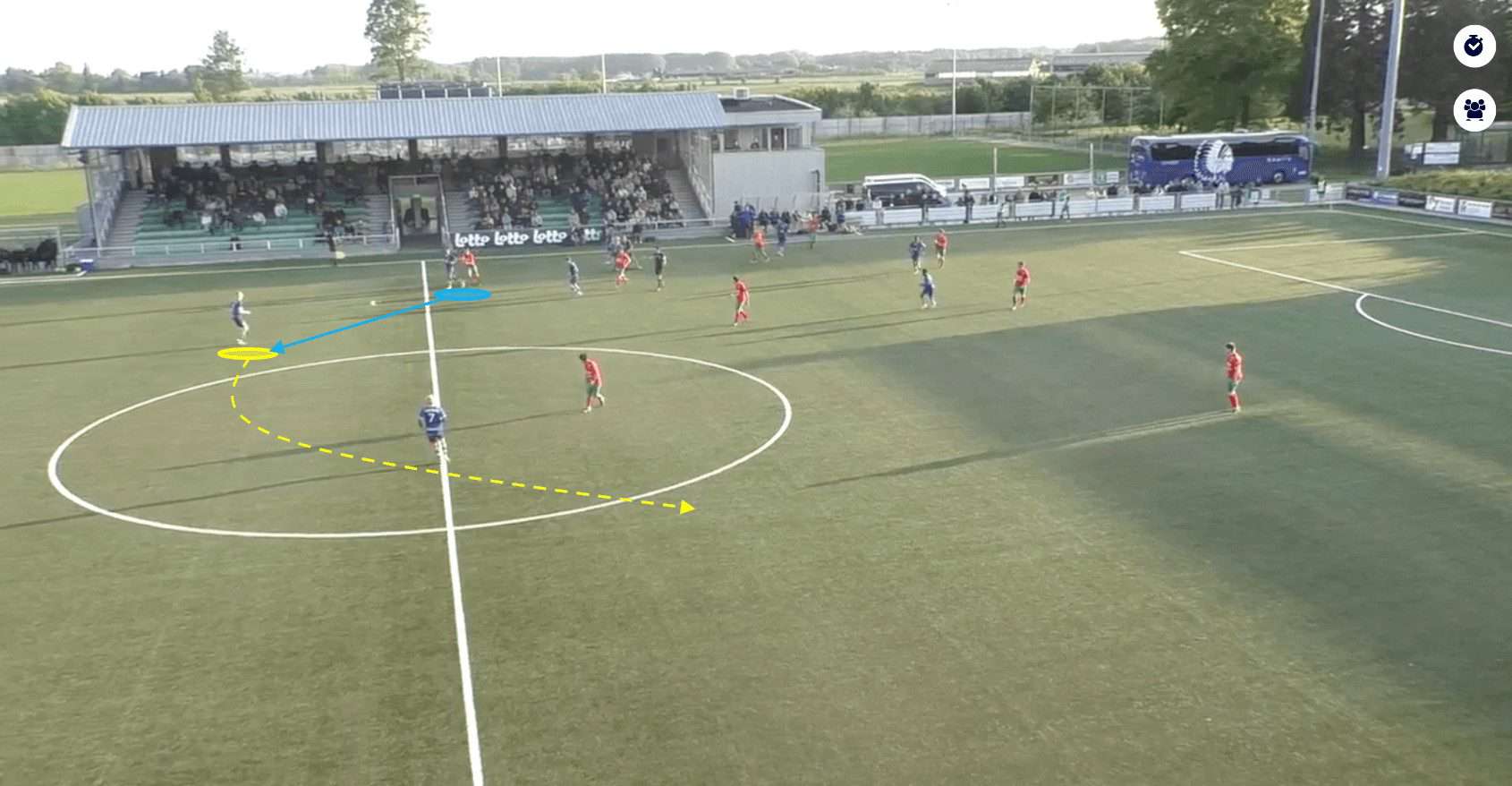
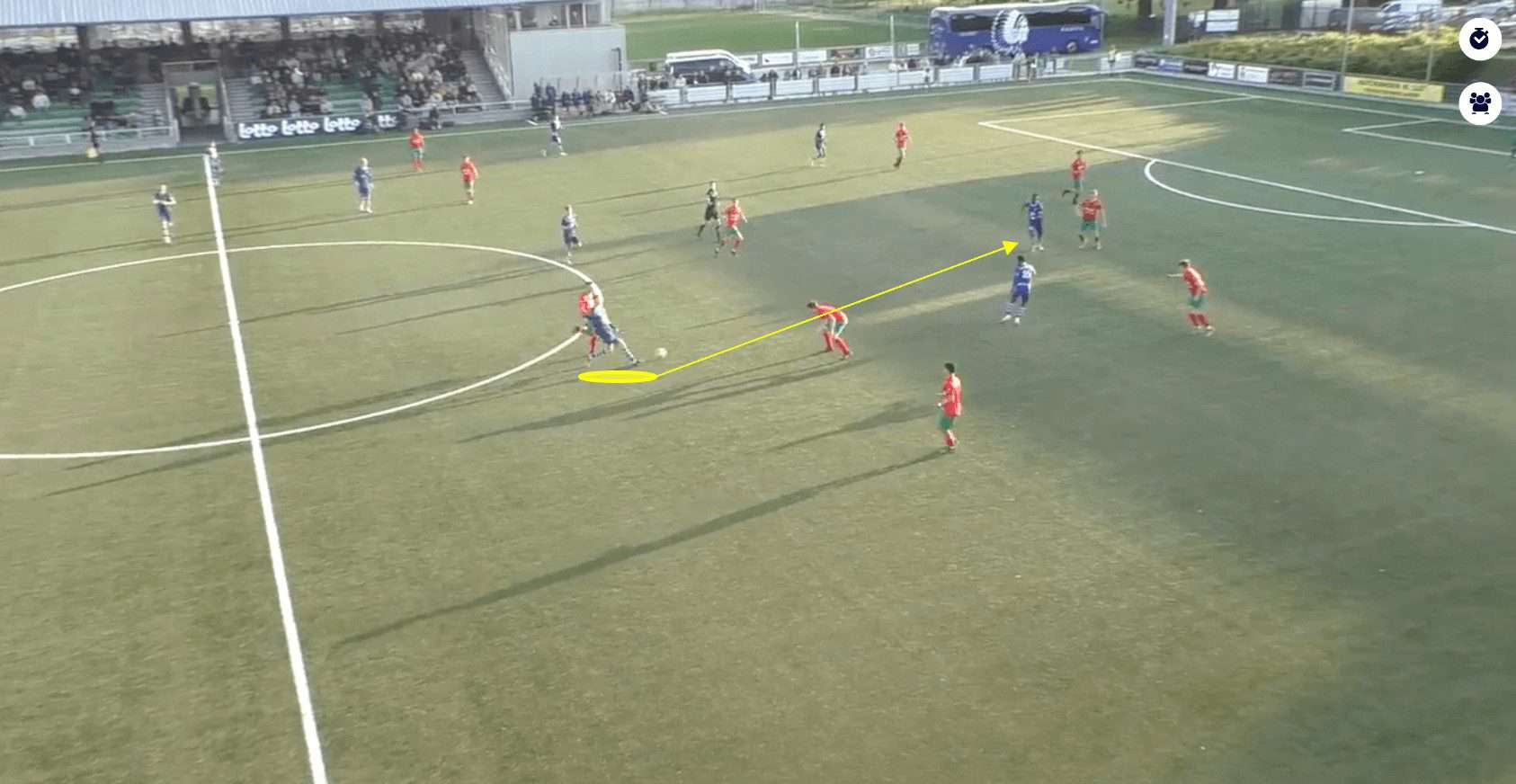
Regarding carrying the ball out of defence, Henry is perhaps not as comfortable in possession as Mokio and Thienpont. He certainly does not shy away from progressing the ball but will only look to do so if there is open space ahead of him, as shown in the example above. If he is under pressure, he will generally not rely on his dribbling skills to beat an opponent, much preferring to pass the ball instead.
Furthermore, Henry typically looks to release the ball when he enters the opposition half. The 21-year-old rarely marauds forward as Thienpont does. Although he is slightly less progressive in his style of play, Henry prioritises ball retention, which sees him chalk up an 89% passing accuracy rating and ensures that Gent can methodically build from the back.
Loris Henry is perhaps the weakest of the three defenders in this scout report in terms of his abilities, but he shows an excellent physical presence and defensive reading of the game. Thienpont and Mokio certainly bring more in terms of ball progression, but the 21-year-old’s recovery runs and last-gasp defending could be useful if Gent’s defensive line is breached.
Conclusion
In this tactical analysis, we have highlighted three centre-backs who could potentially step into Gent’s first team based on their current tactics. Loris Henry is a 21-year-old who reads the game well and uses this to his advantage in defensive situations.
Meanwhile, Nicolas Thienpont is every inch the modern ball-playing defender with his progressive runs forward. Jorthy Mokio utilises his phenomenal athletic ability to kickstart counterattacks and beat his opponent in 1v1 situations.
There are some wonderful talents within Gent’s youth system, and this scout report has highlighted just three of them. The Belgian team are one to watch out for in the future.



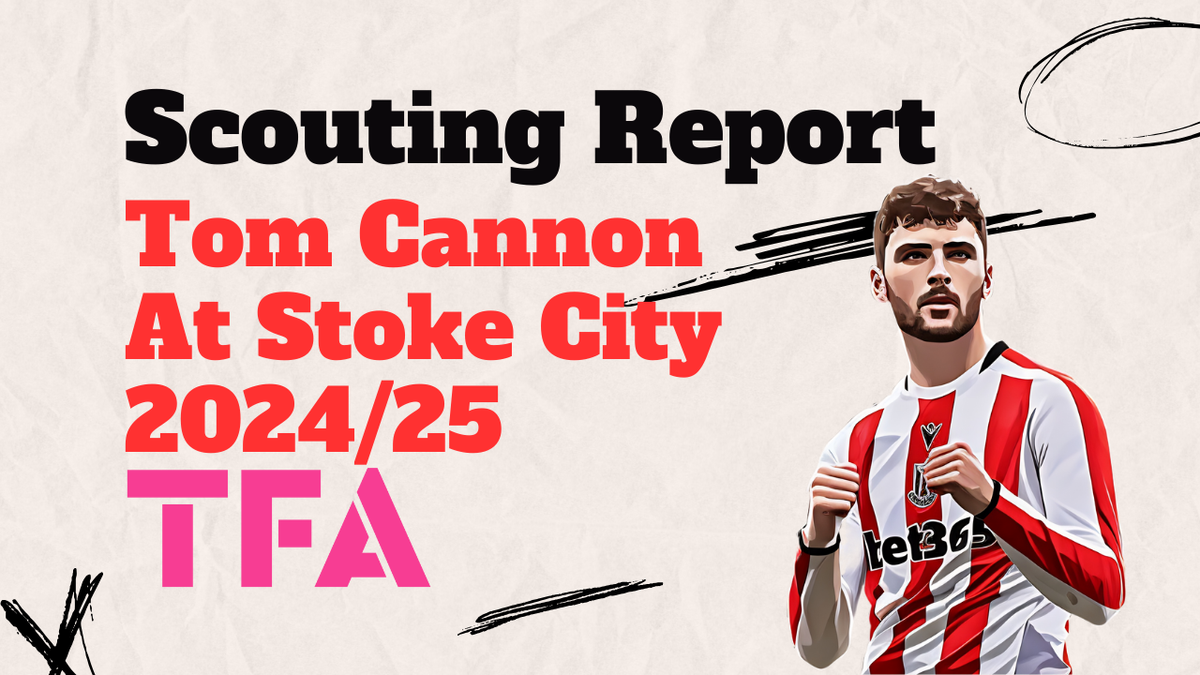

Comments